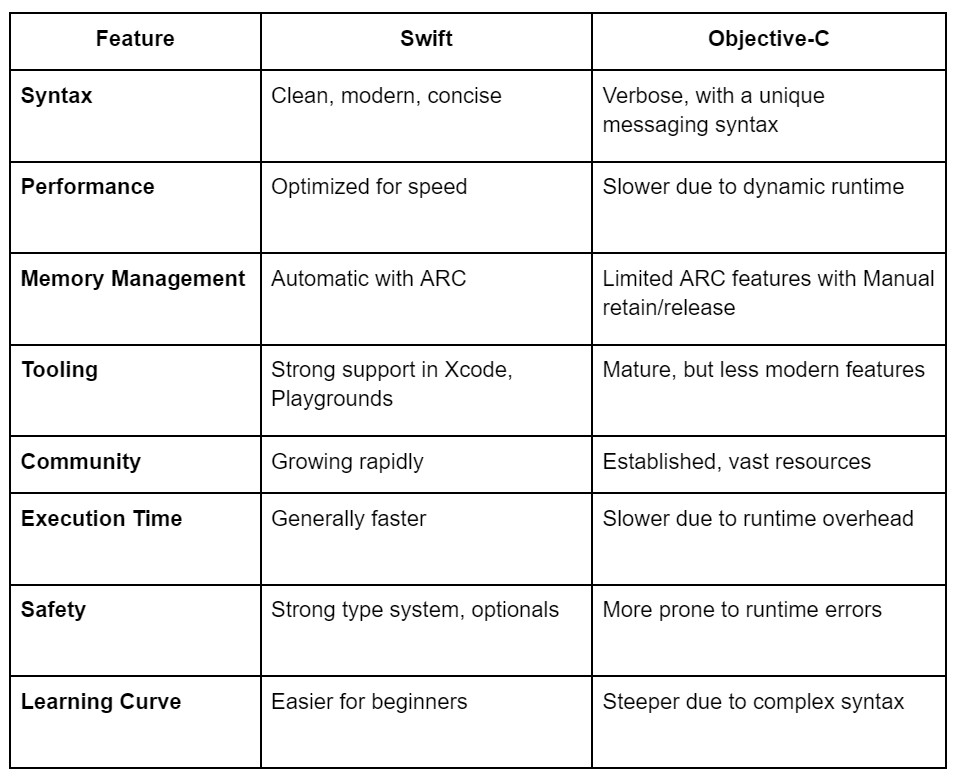Choosing between Swift and Objective-C can feel like standing at a crossroads for many developers. The programming language you select is a critical decision that can significantly influence project timelines, future maintenance, and even your job satisfaction. Concerns often arise about the learning curve, performance issues, and compatibility with existing codebases. In this comprehensive blog, we’ll explore swift versus objective c to help you make an informed choice based on various factors.
Contents:
What is Swift?
Swift is a powerful and intuitive programming language for iOS, macOS, watchOS, and tvOS. It was introduced by Apple in 2014 and is easy to use, modern, and capable of producing lightning-fast applications. Swift’s syntax is concise yet expressive. Both- beginners and seasoned developers can benefit from its ease of use.
Features of Swift
When Apple introduced Swift, it aimed to revolutionize iOS development by addressing many shortcomings found in Objective-C. This fresh approach came with features designed to make coding easier, safer, and more efficient. Here are some standout features that have made Swift a popular choice among developers:
Safety
Swift eliminates entire classes of unsafe code. This ensures variables are always initialized before use and prevents common errors that can cause apps to crash. By catching errors early in the development process, Swift reduces the chances of bugs making it into production.
Performance
Swift is designed to be fast. Its compiler and standard library are optimized for performance. This means Swift code runs quickly and efficiently. This optimization helps in creating high-performance applications that can handle complex tasks and large data sets smoothly.
Modern syntax
Swift’s syntax is clean and easy to read. It reduces the amount of boilerplate code (repetitive code patterns), making the codebase easier to write and maintain. This modern syntax is designed to be more intuitive. Developers can now understand the structure and flow of the code quickly.
Playgrounds
Interactive Playgrounds in Xcode allow developers to experiment with code and see results in real-time. Prototyping and learning are made easier with this feature. It helps visualize how changes to the code affect the application by providing instant feedback.
Optionals
Swift’s type system includes optionals – a way to handle the absence of values. An optional can either contain a value or be nil. This helps prevent runtime crashes due to unexpected nil values, as optionals require explicit handling of cases where a value might be missing. For example, when retrieving data from a network request that might fail, using optionals ensures that the potential absence of data is managed safely.

Car Rental Mobile App Design Concept by Conceptzilla
What are the advantages of Swift?
iOS programming language Swift offers numerous advantages that make it a popular choice among developers. Here are some key benefits:
- Readability: Swift’s syntax and language constructions make it easier to read and write. This reduces the time needed for new developers to understand the codebase.
- Maintenance: Swift requires less maintenance because it manages memory automatically with Automatic Reference Counting (ARC).
- Interoperability: Swift is fully interoperable with Objective-C. This allows seamless integration into existing projects.
- Support and Updates: As a language developed and supported by Apple, Swift receives regular updates and support. This keeps your system relevant and up-to-date.
Now that we understand the strengths and intricacies of Swift, let’s get to know more about Objective-C and how to choose between the two languages.
What is Objective-C?
Objective-C is a general-purpose, object-oriented programming language. C is given small talk-style messaging. Apple, for iOS and macOS development, used Objective-C as their main programming language before the advent of Swift.
Features of Objective-C
While Swift may be the new kid on the block, Objective-C holds its ground with a rich legacy and robust feature set. Understanding Objective-C’s features can provide valuable insights into its enduring presence:
Dynamic Typing
Objective-C supports dynamic typing. This means the type of an object is determined at runtime rather than at compile time. This flexibility allows developers to write more adaptable and flexible code. For example, you can pass around objects without needing to specify their type upfront, simplifying complex codebases.
Message syntax
Objective-C uses a messaging syntax derived from Smalltalk. Instead of calling methods directly, you send messages to objects, which the runtime interprets. This allows for dynamic method resolution. This means the exact method to be executed can be determined at runtime, offering more flexibility and dynamic behavior.
Compatibility
One of Objective-C’s strongest features is its compatibility with C and C++ code. This lets you incorporate existing C/C++ libraries and tools into your Objective-C projects, facilitating code reuse and integration with legacy systems. This is particularly useful for developers who need to maintain or extend older codebases.
Rich legacy
Objective-C has been in use for decades, resulting in a vast amount of libraries, tools, and community knowledge. This long history means there is a wealth of resources available. This includes extensive documentation, tutorials, and a large community of experienced developers who can offer support and guidance.

Code-Styled App Concept by Conceptzilla
What are the advantages of Objective-C?
Objective-C offers numerous advantages:
- Maturity: Objective-C is a mature language with a large body of work and a proven track record in iOS development.
- Flexibility: The language’s dynamic typing and messaging capabilities provide a high degree of flexibility.
- Integration: Objective-C integrates seamlessly with C and C++ for easy access and leverage of existing codebases.
- Community: A vast amount of documentation, tutorials, and community support is available due to Objective-C’s long history.
Comparison: Swift vs Objective C
Developers often find themselves in a dilemma when talking about Swift vs Objective C. Each language offers unique benefits and challenges. Here’s a breakdown of the critical aspects of both languages:

Key differences between Swift vs Objective-C
Syntax
The syntax of a programming language significantly impacts development speed and code readability. Swift’s clean, modern syntax reduces boilerplate code, making it easier to read and write. Objective-C features a more verbose, lengthy, and complex syntax that can be daunting for beginners but provides extensive flexibility and control.
Performance
Swift is designed to outperform Objective-C. And it does this by being 2.5 times faster and using 60% fewer codes. With its highly optimized compiler and static type system, Swift code tends to execute faster. Objective-C’s dynamic runtime can introduce performance overhead, making it generally slower in comparison.
Memory management
Swift handles memory management automatically using Automatic Reference Counting (ARC). The result is a simpler development process and a reduced risk of memory leaks. Swift’s advanced memory allocation and lack of garbage collection make it faster and more efficient. Objective-C also uses ARC but requires more manual intervention, particularly when dealing with legacy C code.
Tooling and community
Swift benefits from modern tooling support, including real-time code testing with Playgrounds in Xcode. Its community, while newer, is rapidly growing. Objective-C, with its long history, enjoys a vast array of mature tools and a well-established community of developers.
Execution time
Swift typically offers faster execution times due to its static typing and optimized compiler. Objective-C’s execution time can be slower due to its dynamic nature, introducing additional runtime overhead.
Security & safety
Swift’s strong type system and use of optionals significantly enhance code safety. This prevents common programming errors. Objective-C, while flexible, is more prone to runtime errors and requires more diligence from developers to maintain code safety.
Learning curve
Swift is considered easier to learn, thanks to its straightforward syntax and modern language features. Objective-C has a steeper learning curve, with its complex syntax and extensive use of pointers.
Documentation and community support
Objective-C has been in use for over three decades, resulting in extensive documentation and community support. Developers can easily find solutions to their queries on forums like Stack Overflow. Swift, while newer, has a rapidly growing community, and Apple’s strong support ensures ample learning resources are available.
Compatibility
Objective-C’s compatibility with C and C++ makes it versatile and allows the reuse of existing libraries and tools. Swift, however, does not directly support C or C++ code, which can be a limitation for projects that rely on these languages.
Stability
Objective-C is a stable language with minimal changes over the years, making it a reliable choice for long-term projects. Swift, on the other hand, has undergone significant updates since its release. This demands developers to stay current with the latest features and changes.
Interoperability with Objective-C
One of the strengths of Swift is its interoperability with Objective-C. This allows developers to use both languages within a single project, leveraging the strengths of each. This feature is particularly useful for teams transitioning to Swift from an existing Objective-C codebase, as it enables gradual migration without having to rewrite the entire codebase.

Mobile Sport App by Shakuro
Swift’s future prospects
Swift has seen rapid adoption since its release, becoming the primary language for iOS development. Apple’s commitment to the language ensures continuous improvement and support. With features like SwiftUI, a framework for building user interfaces across all Apple platforms, Swift’s future looks promising, providing developers with powerful tools to create sophisticated applications.
Objective-C’s future prospects
Despite the rise of Swift, Objective-C remains relevant, especially for maintaining and updating legacy systems. Many established apps still use Objective-C, ensuring continued demand for developers proficient in it. Its deep integration with C and C++ also makes it indispensable for certain projects. While new development is likely to favor Swift, Objective-C’s robust ecosystem and mature tools will keep it in use for years to come.
Conclusion: which one should you choose?
Objective-C is 32 years old. But, it’s still relevant for maintaining legacy codebases and projects that require integration with C or C++ libraries. Its mature ecosystem and established community make it a reliable choice for ongoing development in existing applications. Objective-C’s dynamic typing and message-passing features provide flexibility, making it indispensable for certain complex applications and integrations.
However, in the game of Objective C vs Swift, the latter is the clear choice for new projects. It offers modern features, better performance, and a more accessible syntax. It’s particularly suitable for developers looking to leverage the latest advancements in iOS development. Swift’s safety features, like optionals and type inference, reduce bugs and make code easier to maintain. It has interactive Playgrounds and fast performance optimization making it ideal for both beginners and experienced developers looking for efficiency and modern tooling.
Nearly 63% of all mobile app developers now prefer Swift over Objective-C for iOS development, reflecting the growing trend toward modern development practices.
